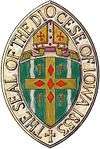Episcopal Diocese of Iowa
| Diocese of Iowa | |
|---|---|
 | |
| Location | |
| Ecclesiastical province | Province VI |
| Subdivisions | 10 Mission Chapters[1] |
| Statistics | |
| Congregations | 61[1] |
| Members | 7,717 (2015) |
| Information | |
| Rite | Episcopal |
| Cathedral |
Cathedral Church of St. Paul, Des Moines Trinity Cathedral, Davenport |
| Current leadership | |
| Bishop | Alan Scarfe |
| Map | |
 Location of the Diocese of Iowa | |
| Website | |
|
www | |
The Episcopal Diocese of Iowa is the diocese of the Episcopal Church in the United States of America which covers all of Iowa. It is in Province VI. Its offices are in Des Moines, and it has two cathedrals: the Cathedral Church of St. Paul in Des Moines and Trinity Cathedral in Davenport.
History

The Episcopal Church in Iowa can trace its roots to 1836 when services were held occasionally in Dubuque by Richard F. Cadle. He was followed by E. G. Gear and J. Batchelder. Philander Chase, Bishop of Illinois, visited Scott County in the fall of 1837.[2]
The church started to develop across the state of Iowa. In July, 1853, Jackson Kemper, missionary bishop of the Northwest, invited clergy and representatives of all the congregations in the state to meet at Trinity Church in Muscatine. On Wednesday, August 17, Alfred Louderback, rector of Trinity Church, Davenport, was elected chairman in the bishop's absence. The constitutions and canons for the diocese were adopted and plans were made for the election of a bishop. The General Convention of the Protestant Episcopal Church in the United States of America admitted the Diocese of Iowa to its membership in October, 1853.
On May 31, 1854, the first convention of the Diocese of Iowa began in Trinity Church, Davenport. Henry Washington Lee, rector of St. Luke's Church, Rochester, New York, was elected the first bishop of Iowa. He was consecrated in his church in Rochester on October 18, 1854. Lee preached in the diocese for the first time on October 29, 1854 in St. John's Church, Dubuque.[2]
The cornerstone for Trinity Cathedral, then called Grace Cathedral, was laid in 1867. The building was completed in 1873. It is the second church built as a cathedral in the Episcopal Church in the United States.[3] In 1992 St. Paul's Church in Des Moines was named the diocese's liturgical cathedral and Trinity was maintained as its historic cathedral.[4] Trinity, St. Paul's and 18 other Episcopal churches in Iowa are listed on the National Register of Historic Places.
Coat of arms
The present Coat of Arms for the Diocese of Iowa were designed by Cram and Ferguson and approved at the 1946 Diocesan Convention. The arms consist of the a field of green, which represents Iowa's prairies, bisected by two lines that represent the Mississippi River and the Missouri River. The gold cross contains five red diamonds which represent the five communities where the Episcopal Church in Iowa was organized: Dubuque, Davenport, Muscatine, Burlington, and Keokuk. The cross is surrounded by four ears of corn that represents Iowa’s agricultural heritage. A bishop's mitre tops the shield and it is surrounded by the words, "Seal of the Diocese of Iowa 1853." [5]
Companion Dioceses


 The Diocese of Brechin is part of the Scottish Episcopal Church and is located in North East Scotland. It is the smallest of the seven dioceses in Scotland. The cathedral and administrative offices are in Dundee.[6] The two dioceses entered into companion status in 1982 and it was officially recognized by the Episcopal Church (US) in 1990.[7]
The Diocese of Brechin is part of the Scottish Episcopal Church and is located in North East Scotland. It is the smallest of the seven dioceses in Scotland. The cathedral and administrative offices are in Dundee.[6] The two dioceses entered into companion status in 1982 and it was officially recognized by the Episcopal Church (US) in 1990.[7] The Diocese of Swaziland is located in southern Africa, and encompasses the entire country of Swaziland. The diocese is part of the Anglican Church of Southern Africa.[8] The two dioceses entered into companion status in 1988 and it was officially recognized by the Episcopal Church (US) in 1990.[7]
The Diocese of Swaziland is located in southern Africa, and encompasses the entire country of Swaziland. The diocese is part of the Anglican Church of Southern Africa.[8] The two dioceses entered into companion status in 1988 and it was officially recognized by the Episcopal Church (US) in 1990.[7]
 The Diocese of Nzara is situated in the southwest corner of the new Republic of South Sudan. It is a member of the Episcopal Church of Sudan. The two dioceses entered into companion status in October 2012.[9]
The Diocese of Nzara is situated in the southwest corner of the new Republic of South Sudan. It is a member of the Episcopal Church of Sudan. The two dioceses entered into companion status in October 2012.[9]
Bishops
| Bishops over Iowa | |||
|---|---|---|---|
| From | Until | Incumbent | Notes |
| 1838 | 1854 | Jackson Kemper, Missionary Bishop of the Northwest | Bishop over the Territory of Iowa beginning in 1838 and the State of Iowa beginning in 1846. |
| Bishops of Iowa | |||
| From | Until | Incumbent | Notes |
| 1854 | 1874 | Henry Washington Lee | Also served as Provisional Bishop of Nebraska (1857–1859) and Provisional Bishop of Kansas (1860-1864) while Bishop of Iowa. |
| 1876 | 1898 | William Stevens Perry | |
| 1899 | 1929 | Theodore Nevin Morrison | |
| 1929 | 1943 | Harry Sherman Longley | Suffragan bishop from 1912–1917. Coadjutor bishop since 1917. |
| 1944 | 1949 | Elwood Lindsay Haines | |
| 1950 | 1971 | Gordon V. Smith | |
| 1972 | 1988 | Walter Cameron Righter | Assistant Bishop of Newark (1989-1991) |
| 1988 | 2001 | C. Christopher Epting | Coadjutor bishop since September 1988, resigned to become the Episcopal Church's deputy for Ecumenical and Interreligious Relations and became Assistant Bishop of Chicago in 2012. |
| 2003 | present | Alan Scarfe[10] | |
References
- 1 2 "Who We Are". www.iowaepiscopal.org. Archived from the original on 2010-07-05. Retrieved 2010-04-12.
- 1 2 "Chapter XX: Churches and Parishes". Scott County Iowa USGenWeb Project. Retrieved 2010-04-12.
- ↑ Horton, Loren N. (2003). The Beautiful Heritage: A History of the Diocese of Iowa. Des Moines: Diocese of Iowa. p. 44.
- ↑ Horton, 121
- ↑ Horton, 88
- ↑ "Companion Relationship with the Diocese of Brechin". www.iowaepiscopal.org. Archived from the original on 2010-07-05. Retrieved 2010-04-12.
- 1 2 "Companion Dioceses". www.iowaepiscopal.org. Archived from the original on 2013-09-15. Retrieved 2013-11-28.
- ↑ "Companion Relationship with the Diocese of Swaziland". www.iowaepiscopal.org. Archived from the original on 2010-07-05. Retrieved 2010-04-12.
- ↑ "Companion Relationship with the Diocese of Nzara in South Sudan". www.iowaepiscopal.org. Archived from the original on 2013-09-15. Retrieved 2013-09-28.
- ↑ "Bishop". www.iowaepiscopal.org. Archived from the original on 2010-07-05. Retrieved 2010-04-12.
External links
Coordinates: 41°34′53″N 93°39′58″W / 41.5815°N 93.666°W